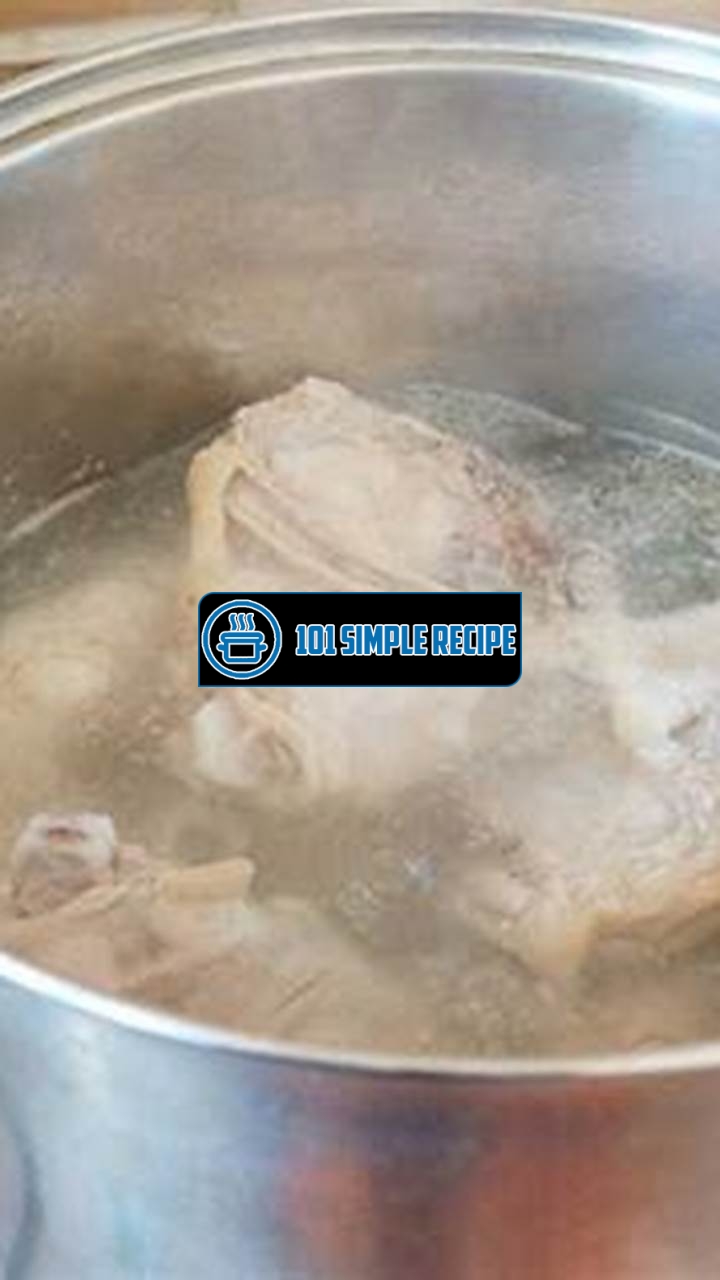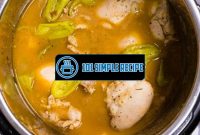Boiling chicken seems like a simple and straightforward process: just throw the chicken into a pot of boiling water and wait for it to cook, right? Well, you might be surprised to learn that boiling chicken actually takes longer than you think. In fact, there are several factors at play that contribute to the extended cooking time. First and foremost, the size and thickness of the chicken pieces play a crucial role in determining the cooking time. Thicker pieces of chicken will naturally require more time to cook through. Additionally, the temperature of the water and the desired level of doneness also impact the cooking time. So, before you embark on your next chicken boiling adventure, make sure you are prepared for the patience it requires.

The Science Behind Boiling Chicken
When it comes to cooking chicken, boiling is one of the most commonly used methods. It is a simple and straightforward way to cook chicken, but have you ever wondered why it takes longer than you think? Let’s delve into the process and science behind boiling chicken, so you can better understand how long it takes to achieve the desired results.
Boiling chicken involves submerging it in a liquid and heating it until it reaches the desired level of doneness. The chicken absorbs the flavors of the liquid, making it a great method for creating flavorful dishes such as soups or stews. However, the cooking time can vary depending on several factors.
The Role of Temperature in Boiling Chicken
The temperature at which you boil chicken plays a crucial role in determining how long it takes to cook. Water boils at 212°F (100°C) at sea level, but higher altitudes can cause the boiling point to decrease. The higher the temperature, the faster the chicken will cook. However, cooking chicken at a rolling boil can result in a tougher and drier texture.
It is recommended to bring the water to a gentle simmer, around 165°F to 185°F (74°C to 85°C), to achieve tender and juicy boiled chicken. This lower temperature allows the chicken to cook more evenly, giving it a tender texture while still retaining its moisture.
How Different Cuts of Chicken Affect Boiling Time
The cut of chicken you are boiling also affects the cooking time. Each cut has a different thickness and composition, which can impact how long it takes to cook through.
For example, boneless, skinless chicken breasts are a popular choice for boiling as they cook relatively quickly. They usually take around 15 to 20 minutes to reach the desired internal temperature of 165°F (74°C).
On the other hand, bone-in chicken pieces, such as drumsticks or thighs, require a longer cooking time. The bones in these cuts act as insulators, slowing down the heat transfer and increasing the overall cooking time. It can take anywhere from 25 to 40 minutes for bone-in chicken pieces to fully cook through.
Factors That Influence the Cooking Time of Boiled Chicken
In addition to temperature and the type of cut, there are several other factors that can influence the cooking time of boiled chicken.
1. Size of the chicken pieces: Smaller pieces will cook faster than larger ones.
2. Freshness of the chicken: Fresher chicken will generally cook more quickly than older chicken.
3. Starting temperature of the chicken: Chicken that has been brought to room temperature before boiling will cook faster compared to chicken taken directly from the refrigerator.
4. Altitude: As mentioned earlier, higher altitudes have lower boiling points, which can affect the cooking time.
5. Desired level of doneness: If you prefer your chicken to be more well-done, it will naturally take longer to cook.
It’s important to keep these factors in mind when boiling chicken to ensure that it is cooked to perfection.
In summary, boiling chicken takes longer than you may think due to factors such as temperature, cut of chicken, and various other influences. It is essential to find the right balance between cooking the chicken thoroughly and avoiding overcooking, which can result in dry and tough meat. By understanding the science behind boiling chicken, you can achieve delicious and perfectly cooked chicken every time.
Preparation and Seasoning for Boiling Chicken
Properly preparing and seasoning chicken before boiling is essential to enhance its flavor and tenderness. By following these essential steps, you can ensure that your boiled chicken turns out delicious every time.
How to Clean and Prep Chicken for Boiling
Before you start boiling the chicken, it is crucial to clean and prep it properly. This step ensures that any impurities are removed and that the chicken is ready to absorb the flavors of the seasoning.
Start by rinsing the chicken under cold water to remove any excess blood or residue. Pat it dry with paper towels to get rid of any excess moisture. Then, remove any giblets or organs from the cavity and discard them.
To further enhance the texture and tenderness of the chicken, you can choose to brine it. Brining involves soaking the chicken in a mixture of water, salt, and sometimes sugar, for a period of time. This process helps the chicken retain moisture during cooking and results in a juicier end product.
Note: Brining can add extra flavor to your chicken and prevent it from drying out during the boiling process. However, if you are short on time, you can skip this step.
Once the chicken is clean and prepped, it is ready to be seasoned for boiling.
The Importance of Proper Seasoning for Boiled Chicken
Seasoning the chicken before boiling is crucial to infuse it with flavor. While boiling alone can help cook the chicken, adding the right blend of seasonings takes it to the next level.
A basic combination of salt, pepper, and garlic powder works well for seasoning boiled chicken. These ingredients enhance the natural taste of the meat and provide a simple yet satisfying flavor profile.
If you’re looking to amp up the flavors, you can experiment with different herbs and spices. Some popular options include paprika, thyme, rosemary, and oregano. You can also add a kick of heat with chili powder or cayenne pepper.
Remember that the amount of seasoning to use depends on personal preference. Start with a small amount and taste the chicken as it cooks. You can always add more seasoning if needed.
Seasoning Variations for Different Flavor Profiles
Boiled chicken can take on various flavor profiles depending on the seasonings used. Here are a few variations to consider:
- Asian-inspired: Use soy sauce, ginger, garlic, and a touch of sesame oil for a flavorful Asian twist.
- Mediterranean: Opt for a combination of lemon juice, olive oil, oregano, and garlic to bring out the fresh and vibrant flavors of the Mediterranean cuisine.
- Barbecue-style: If you prefer a smoky and tangy flavor, use barbecue sauce, paprika, brown sugar, and a hint of liquid smoke.
- Cajun-spiced: Create a spicy and bold flavor by using Cajun seasoning, garlic powder, onion powder, and cayenne pepper.
Feel free to get creative with your seasonings and adapt them to suit your taste preferences. The key is to experiment and find combinations that bring out the best in your boiled chicken.
By properly preparing and seasoning your chicken before boiling, you can elevate its taste and tenderness. Whether you stick to the basics or try out different flavor profiles, the result will be a delicious and satisfying dish that you and your family can enjoy!
If you’re in the mood for a refreshing drink, try making a pink drink. This vibrant beverage is made with a combination of strawberry acai refresher, coconut milk, and freeze-dried strawberries. It’s the perfect summer drink to enjoy on a hot day.
Boiling Techniques for Perfectly Cooked Chicken
Mastering different boiling techniques is crucial to ensuring your chicken is cooked thoroughly while remaining juicy and flavorful. Whether you prefer the slow and steady simmering method or the quick and convenient rapid boiling technique, understanding the science behind these methods will help you achieve the perfect chicken every time.
The Simmering Method: Slow and Steady Wins the Race
The simmering method is a traditional and time-tested technique that yields perfectly cooked chicken. To simmer chicken, you need to bring a pot of water to a gentle boil and then reduce the heat to maintain a low simmer. This allows the chicken to cook slowly and evenly, resulting in tender and succulent meat.
One key advantage of the simmering method is that it gives you more control over the cooking process. You can easily adjust the heat to prevent overcooking and ensure the chicken remains moist. It’s important to take note of the cooking time as it may vary depending on the size and thickness of the chicken pieces.
Important: Simmering the chicken for approximately 30-40 minutes, or until the internal temperature reaches 165°F (74°C), is generally recommended.
In addition to using the simmering method for cooking chicken on its own, it’s also a great way to prepare chicken for other dishes like soups, stews, and stir-fries. The slow and gentle cooking process allows the flavors to meld together beautifully, resulting in a rich and satisfying meal.
Rapid Boiling: Quick and Convenient, But Watch the Clock
If you’re short on time and looking for a faster boiling method, rapid boiling comes to the rescue. This technique involves bringing a pot of water to a rolling boil and then adding the chicken. The high heat and vigorous bubbling ensure a speedy cooking process, making it ideal for busy weeknight meals.
However, it’s crucial to watch the clock and avoid overcooking the chicken when using the rapid boiling method. Chicken that is cooked at too high a temperature or for too long can turn out tough and rubbery. It’s best to use this method for smaller, boneless chicken pieces that cook quickly.
Remember: It is recommended to boil the chicken for approximately 10-15 minutes, or until the internal temperature reaches 165°F (74°C).
Rapid boiling can be a great technique for preparing chicken for sandwiches, salads, or adding to pasta dishes. The quick cooking time ensures tender and moist chicken, allowing you to create delicious meals in a matter of minutes.
Adding Aromatics and Broth for Enhanced Flavor
While boiling chicken on its own can create a tasty base for various recipes, adding aromatics and broth takes the flavor to a whole new level. Aromatics, such as garlic, onions, herbs, and spices, infuse the chicken with enticing flavors while it cooks.
To enhance the taste even further, consider using chicken broth instead of plain water. The broth adds depth and richness to the chicken, making it more flavorful and delicious. You can also experiment with different types of broths, such as vegetable or bone broth, to create unique flavor profiles.
Note: It’s essential to use low-sodium broth or adjust the seasoning accordingly to control the saltiness of the final dish.
Adding aromatics and broth is a versatile technique that can be used in conjunction with either the simmering or rapid boiling method. Whether you’re preparing chicken for a homemade soup, a comforting stew, or a flavorful stir-fry, this step will elevate the taste and make your dish truly memorable.
In conclusion, mastering the art of boiling chicken requires an understanding of different techniques along with the ability to adapt to varying recipes and preferences. Whether you choose the slow and steady simmering method or the quick and convenient rapid boiling technique, the key is to pay attention to cooking times and temperatures to ensure your chicken is cooked thoroughly. Moreover, adding aromatics and broth offers endless possibilities for enhancing the flavor of your chicken dishes. So, go ahead and experiment with these boiling techniques to create perfectly cooked, delicious chicken every time!
If you’re looking for a delicious and easy dessert recipe, try making peanut butter cups. These simple treats are made with a creamy peanut butter filling that’s surrounded by rich chocolate. They’re perfect for satisfying your chocolate cravings.
Signs That Your Boiled Chicken Is Ready
When it comes to boiling chicken, it’s important to know when it’s cooked to perfection. Overcooking can result in dry and tough chicken, while undercooking can lead to a risk of foodborne illnesses. By learning to recognize the visual and sensory cues, you can ensure that your boiled chicken is ready to be enjoyed. Here are some of the signs that indicate your chicken is cooked just right.
Checking Internal Temperature with a Meat Thermometer
One of the most accurate ways to determine if your boiled chicken is cooked is by checking its internal temperature. Using a meat thermometer, take the temperature at the thickest part of the chicken. The chicken should reach an internal temperature of at least 165°F (74°C) for it to be considered safe to eat. This ensures that any harmful bacteria present in the chicken are killed off during the cooking process. Remember to clean your thermometer between measurements to avoid cross-contamination.
Using the Fork and Knife Test for Doneness
If you don’t have a meat thermometer on hand, you can use the fork and knife test to check the doneness of your boiled chicken. Carefully insert a fork or knife into the thickest part of the chicken. If the juices run clear and the meat is no longer pink, it is a good indication that the chicken is cooked through. Additionally, the chicken should feel firm and not rubbery when touched with the utensil.
Observing Juice Color and Consistency for Proper Cooking
Another way to determine if your boiled chicken is ready is by observing the color and consistency of the juices that come out of the chicken. Once cooked, the juice should be clear, not pink or bloody. Additionally, the consistency of the juice should be slightly thickened, indicating that the chicken has reached the desired level of doneness. This visual cue can be a helpful indicator of whether your chicken is properly cooked.
It’s important to note that the cooking time for boiled chicken can vary depending on factors such as the size and thickness of the chicken pieces, as well as the altitude and the intensity of the heat. It’s always best to use a meat thermometer to ensure that your chicken is fully cooked. Remember, food safety is key when handling poultry, and thorough cooking is essential to avoid any potential health risks.
In conclusion, by recognizing these signs, you can confidently determine if your boiled chicken is ready to be served. Whether you use a meat thermometer or rely on visual cues, it’s crucial to ensure that your chicken is cooked thoroughly to guarantee both safety and deliciousness.
For a quick and easy dinner recipe, try making magic bars. They are made with a delicious combination of graham cracker crumbs, sweetened condensed milk, chocolate chips, and coconut flakes. These bars are perfect for satisfying your sweet tooth.
Storing and Utilizing Boiled Chicken
When it comes to boiled chicken, knowing the best practices for storing and utilizing leftover portions can make a significant difference in your future meals. Proper storage techniques not only ensure the safety of the chicken but also help maintain its taste and texture. Whether you want to use it for a quick salad or incorporate it into a flavorful casserole, here are some tips to help you make the most out of your boiled chicken.
Safe Storage and Shelf Life of Boiled Chicken
Ensuring the safety of boiled chicken is crucial to avoid any potential foodborne illnesses. After boiling the chicken, you must store it properly to maintain its freshness and prevent bacterial growth. The shelf life of boiled chicken in the refrigerator is typically around three to four days.
- ✅ Store the boiled chicken in airtight containers or resealable bags to prevent exposure to air and moisture.
- ✅ Label the containers with the date of storage to keep track of its freshness.
- ✅ Place the containers at the back of the refrigerator, where the temperature remains the coldest.
- ✅ Avoid storing the chicken near raw meat, seafood, or vegetables to prevent cross-contamination.
Note: It’s important to discard the boiled chicken if there are any signs of spoilage, such as a foul smell or unusual texture. Always prioritize your health and safety when consuming leftovers.
Creative Ways to Incorporate Boiled Chicken into Recipes
Leftover boiled chicken can be a versatile ingredient to enhance various dishes with its tender and juicy texture. Here are some creative ideas to help you incorporate boiled chicken into your recipes:
- Chicken Salad: Shred the boiled chicken and mix it with crisp lettuce, cherry tomatoes, and a zesty dressing for a refreshing salad option.
- Chicken Pasta: Add diced boiled chicken to your favorite pasta dish along with some sautéed vegetables and a creamy sauce.
- Chicken Stir-Fry: Sauté boiled chicken slices with an assortment of colorful vegetables and a tangy sauce for a quick and healthy stir-fry.
- Chicken Tacos: Fill your tortillas with shredded boiled chicken, fresh salsa, avocado slices, and a sprinkle of cheese for a delicious taco night.
- Chicken Wrap: Create a flavorful wrap by combining boiled chicken, hummus, lettuce, and your favorite veggies in a whole-grain tortilla.
Tips for Freezing and Thawing Boiled Chicken
If you have more boiled chicken than you can consume within the recommended timeframe, freezing it can be a great option. Proper freezing and thawing techniques will help maintain the quality and taste of the chicken.
- Freezing Chicken: Place the boiled chicken in freezer-safe containers or bags, removing as much air as possible. Label the containers with the date of freezing and store them in the coldest part of the freezer (-18°C or 0°F).
- ❄️ Thawing Chicken: To thaw the frozen boiled chicken, transfer it to the refrigerator and allow it to thaw slowly overnight. Alternatively, you can use the defrost setting in your microwave if you need it thawed more quickly.
By following these guidelines, you can make the most out of your boiled chicken, ensuring its safety, maximizing its shelf life, and adding an extra touch of flavor to your meals. Let your creativity soar as you incorporate this versatile protein into various recipes!
Thanks for reading our article on how long it takes to boil chicken! We hope you found the information helpful and informative for your next cooking adventure. If you have any other questions or topics you’d like us to cover, please let us know in the comments below. Happy cooking, and visit again soon!
Frequently Asked Questions
Here are some frequently asked questions about boiling chicken:
| No. | Questions | Answers |
|---|---|---|
| 1 | How long does it take to boil chicken? | It typically takes about 30-40 minutes to boil a whole chicken, depending on its size and thickness. However, it’s always recommended to use a meat thermometer to ensure it reaches an internal temperature of 165°F (75°C) for safety. |
| 2 | Can I boil frozen chicken? | Yes, you can boil frozen chicken. However, it may take longer to cook, so ensure it reaches 165°F (75°C) before consuming. |
| 3 | What seasonings can I add when boiling chicken? | You can add a variety of seasonings to enhance the flavor of boiled chicken, such as salt, pepper, garlic powder, onion powder, or your favorite herbs and spices. Customize it to your taste! |
| 4 | Can I use the boiled chicken broth for soup? | Absolutely! The broth from boiling chicken can be used as a flavorful base for soups, stews, or sauces. Don’t let it go to waste! |
| 5 | Should I remove the skin before boiling chicken? | It’s a personal preference. Leaving the skin on can help retain moisture and flavor, but if you prefer skinless chicken, you can remove it before boiling. |
| 6 | What can I do with leftover boiled chicken? | Leftover boiled chicken is incredibly versatile. You can use it in sandwiches, salads, wraps, or even shred it for tacos or enchiladas. Get creative with your leftovers! |
Thanks for Reading! Come Back Soon for More Tasty Tips and Recipes!
We hope you enjoyed learning about how long it takes to boil chicken. Remember to bookmark our site and come back for more delicious recipes, cooking tips, and culinary inspiration. Whether you’re a seasoned chef or just starting out in the kitchen, we’ve got something for everyone. Stay tuned for our next article and happy cooking!
Jump to Recipe
How Long Does It Take to Boil Chicken

Learn how long it takes to boil chicken to perfection with our handy guide. Whether you’re making chicken soup or need cooked chicken for a recipe, we’ve got you covered. Find out the optimal boiling time, tips, and more!
- 1 whole chicken
- Water
- Salt
- Pepper
- Garlic powder
- Onion powder
- Place the whole chicken in a large pot and cover with water.
- Add salt, pepper, garlic powder, and onion powder to the pot.
- Bring the water to a boil, then reduce heat and let it simmer for 40 minutes or until the chicken reaches an internal temperature of 165°F (75°C).
- Remove the chicken from the pot and let it rest for a few minutes before carving or shredding.






